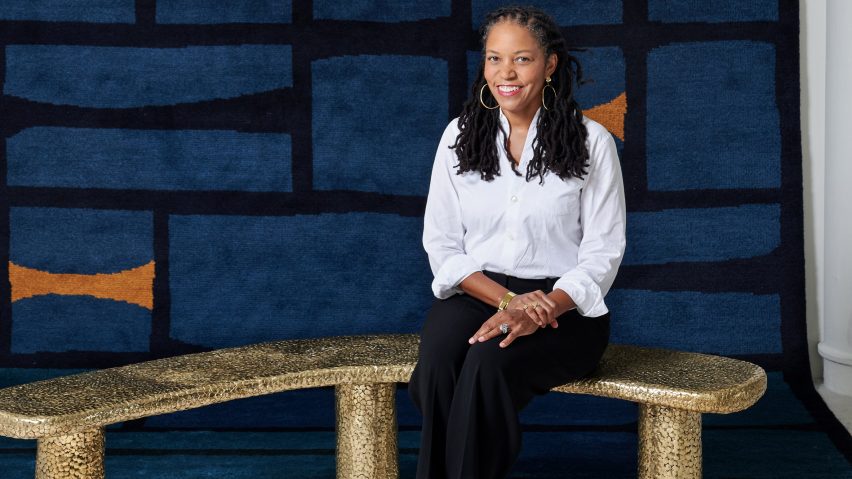A lack of care over design decisions made in public spaces is a key source of inequity in America, New York designer Little Wing Lee tells Dezeen in this interview.
Lee, an interior designer based in Brooklyn, believes that poor design decisions in the public sphere reinforce a cycle of inequity in the built environment.
"When I think about aesthetic justice, my mind first goes to public spaces," she told Dezeen.
"I think about urban planning, urban design, landscape architecture, public housing – we all see that there is this inequity in the consideration given to public works or how public monies are being spent."
"What leadership role can we take?"
Lee said that even the most basic design decisions, such as the temperature of light, are aspects of this lack of consideration, noting that sometimes the choices are not "even about money" but rather a lack of care.
"These decisions are treated as less-than because the people affected have less agency," she said.
"As designers, we know that the negative emotional responses to these choices are universal, but in these instances that is simply overlooked."
Lee, who was a judge for the 2023 Dezeen Awards, wants designers to be more proactive in challenging these issues.
"I would like to see this be a question considered by the broader design community," she said.
"What leadership role can we take to ask this question of our policymakers, our own communities, perhaps even our clients?"
To this end, Lee formed Black Folks in Design (BFiD) in 2017, an organisation that facilitates meetings between architects and designers to talk about problems faced by minorities in the design industry.
Born in New England, Lee lived in Hawaii as a youth and studied at the Pratt Institute and Harvard before setting up shop in Brooklyn where she runs her design practice, Studio & Projects.
Working in interior and object design, Lee first had the idea for BFiD after working on the exhibition design for the Smithsonian Museum of African American History in Washington DC.
"That was such an amazing experience – to be at the table with 20-plus Black designers working on this incredible and beautiful project," she said.
"Black Folks in Design was born out of my desire to create this community of Black designers across all disciplines and, obviously, to share resources and ideas but then to also commiserate and laugh about crazy experiences that we've had working in the design world."
Through network-building, Lee believes that opportunities and resources can be more easily shared between members and among minority communities in general.
She is currently in the process of turning BFiD into an official non-profit, which she said will make fundraising easier and help to organise initiatives such as bringing North American designers to Lagos to interact and share ideas with the designers there.
"As we move Black Folks in Design forward, we can give Black designers some of that flexibility of travel and time," she said.
Lee came up during the maker movement of the 2000s and 2010s – the movement oriented around small studies working in spaces previously inhabited by industrial spaces in Brooklyn.
The movement had a major impact on design globally, and the experience impacted Lee's view of design's ability to reshape inequity, she explained.
"It was a very specific and important time in New York design," she said. "That moment gave everyone a push of confidence."
"More and more people understand the power of design"
"There has been a change in the past 20 years and more people understand the power of design, certainly in how it helps business and the private sector," she continued.
"I think that awareness is also expressed in the public sector, but often these projects have not been evenly distributed, or are inadequately expressed in areas that would benefit the most from them."
In her design work and network building, which Lee views as part of a single practice, a variety of traditions, demographics and approaches to design have informed her thinking.
"Your life is so much more enriched when you have a community of different types of people," she said.
Lee has curated two shows under the BFiD umbrella.
The first was at the Ace Hotel Brooklyn in 2022, and the second, called SPOTLIGHT II, was staged with local gallery Verso, first on Long Island and then in Tribeca.
Lee said that the goal was "to highlight the range of approaches and visions of Black designers working today" while showing various material approaches to craft traditions and historical production techniques.
"As I built the show it was inspiring to see the threads between these pieces reveal themselves," said Lee.
"Most heartening, perhaps, was to discover and build the community between so many of us, which is ultimately the goal of BFiD."
Lee's work with Studio & Projects has also touched on craft traditions. Her recent project, ECHOIC, is a line of textiles that takes influences from West African traditions.
The photography is by Kelly Marshall.
Dezeen In Depth
If you enjoy reading Dezeen's interviews, opinions and features, subscribe to Dezeen In Depth. Sent on the last Friday of each month, this newsletter provides a single place to read about the design and architecture stories behind the headlines.

